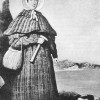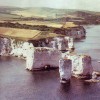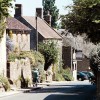On Easter Sunday in April 1471 a small ship docked at Weymouth after a stormy crossing of the Channel from Brittany. Queen Margaret of Anjou was returning to England with her son Prince Edward of Lancaster on a mission to raise an army against the Yorkists at Tewkesbury. Their escort inland for this critical event in the Thirty Year’s War was a rising Dorset born clerical statesman soon to have an important influence on the course of England’s dynastic history – John Morton.
Morton was born in Stileham, Milton St. Andrew, Dorset, in 1420. On his mother’s side he was a descendant of the Turberville family of Bere Regis (the D’Urbervilles of Thomas Hardy’s Tess. Who are commemorated by a stained glass window in the Church.) His grandfather and other members of the family are also buried in the church.
Educated at Cerne Abbey and Balliol College, Oxford, young John graduated in law and went on to study for the priesthood. By 1446 he had become one of the University’s commissioners and was subsequently appointed Moderator of the Civil Law School, Master in Chancery and Chancellor of the Duchy of Cornwall by the time he was about 30. From here on Morton emerged as a most distinguished clerical lawyer, holding several preferment positions, including that of Vicar of Bloxworth. He was to have an important effect on the country’s affairs in the latter half of the 15th century.
This chiefly came about through Morton becoming committed to supporting the Lancastrians during the Wars of the Roses. He probably realised that the cause of the Lancastrian Henry VI was lost, but held office under him and lent his support nevertheless. But after the Yorkist victory at the battle of Towton in 1461, the Earl of Warwick deposed Henry and put Edward IV on the throne. The new king took Henry prisoner and Morton escaped to France wit Henry” other followers, spending several years in exile there with Queen Margaret.
It appears that sometime before 1470 Morton decided to seek the King’s pardon. This Edward granted, and Morton returned from France. But as the King was also aware of Morton’s ability and loyalty to a cause, Edward further appointed him Master of the Rolls, then Bishop of Ely (he plays a minor role as such in Act 3, scene 4 of Shakespeare’s Richard III.) After Edward had been on the throne for a few years he quarrelled with Warwick, who deposed him and restored Henry. But at the battle of Barnet in 1471 Warwick was killed and Henry died, presumed murdered, in prison soon after.
It was at this point that Queen Margaret and Prince Edward returned to England to be escorted by John Morton to Cerne Abbey en route to Tewkesbury. But at the Battle there later in 1471 Edward IV inflicted a defeat upon the Lancastrians and Queen Margaret was taken prisoner, but after paying a ransom was allowed to return broken hearted to France.
For Edward, Morton had been a valued advisor whose duties often took him abroad. When Edward died in 1483 his 12-year old son Edward, Duke of York briefly succeeded as Edward V. But his Uncle Richard, Duke of Gloucester, imprisoned Edward and his younger brother in the Tower where, according to tradition, he had the princes murdered so as to claim the throne for himself as Richard III. The new king’s suspicions about Morton’s loyalty outweighed any regard he had for his abilities as a statesman. On the pretext of some cleverly contrived charge or excuse, Morton was committed to prison, first in the Tower, then later Brecknock Castle. For some months his life would hang by a slender thread, and he faced being murdered, had he not managed to escape.
After this timely breakout Morton joined and sided with Henry Tudor, Earl of Richmond in Brittany, where he helped to plan the Earl’s invasion to oust Richard from the throne. The fatal engagement came at Bosworth, where Richard was killed and Henry came to the throne as Henry VII. As a reward for his loyalty Morton became the first Tudor’s most trusted advisor, being promoted from Commissioner to Chancellor of Oxford University.
Thus Morton helped to establish the Tudor dynasty, but his effect on the course of English history did not end there. He effectively brought the dynastic civil war to its end, ushering in a new age of peace and material progress by advocating in 1486 the marriage of Henry to Elizabeth of York – the future mother of Henry VIII – so symbolically uniting the two royal houses. That year also Morton was appointed Archbishop of Canterbury. The following year he became Lord Chancellor and, in 1493, a Cardinal.
Morton helped Henry accumulate substantial reserves while becoming wealthy himself at the same time. The Cardinal was intensely dedicated to ambitious building and restoration projects, into which he poured much of his personal assets. He rebuilt the palaces of Wisbech and Hatfield, and funded those of Lambeth and Canterbury.
Another re-building venture close to his own heart was the re-ordering of Bere Regis Church, where he constructed the timber roof as a memorial to his parents and also left a legacy for the upkeep of the paintings. He is represented personally in the bosses, the central boss being specially carved to portray the unification of the York and Lancastrian houses. But one of Cardinal Morton’s greatest achievements was the excavation of a great leet or drainage ditch through the East Anglian fens between Peterborough and Wisbech and named Morton’s Dyke after him.
Another facet of the Cardinal’s character was his ingenuity in procuring “benevolences” from the poor and wealthy alike, a practice which gave rise to the expression “Morton’s Fork”. If he heard a nobleman was rich he would say “I hear you are a very rich man, and are surely able to spare some money for the King.” He would then “turn the prong” to the nobleman who lived frugally and say “you are a careful thrifty person who must have saved much money, and some you will be able to spare for the King.” Neither then escaped their obligations to the royal coffers. But Morton did restrain certain financial policies that Henry proposed.
The opinions of contemporary writers about the Cardinal vary considerably however. Many saw him as a strange character, one accusing him of acting “from base and sordid motives,” even of sorcery. As a young man the statesman and writer Sir Thomas More served in the Morton household. He later wrote that Morton was “a man not more venerated for his high rank than for his wisdom and virtue.”
Other writers said he was energetic, sometimes brusque with polished manners, exemplary as a lawyer, one possessed of a great mind and a phenomenal memory. Through discipline and hard study he improved the talents which nature had bestowed upon him. He was a wise man, according to Bacon, but “a harsh and haughty one.” Morton could also be summed up as being accepted by the King, envied by the nobility, but hated by the people.
Cardinal Morton died at Knole, Sevenoaks in Kent in 1500 in his 80th year, and was buried in the crypt of Canterbury Cathedral.



